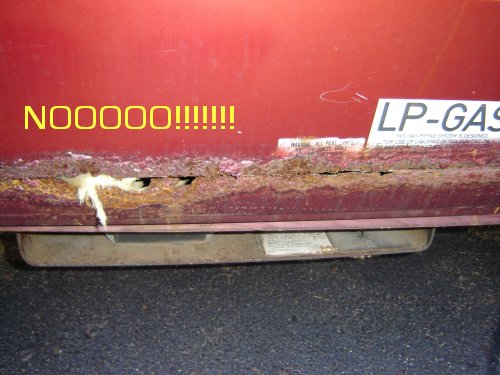I am not a bodyman (just look at how I painted the top), but with the help of some people online and some reading I think I figured a few things out. So if helps someone, great, if not, screw you.
 My seam rust, passenger side rear quarter.
My seam rust, passenger side rear quarter.How I think I got somewhere with my rust.
Click on any picture to blow it up.
I am not a bodyman (just look at how I painted the top), but with the help of
some people online and some reading I think I figured a few things out. So if
helps someone, great, if not, screw you.
 My seam rust, passenger side rear quarter.
My seam rust, passenger side rear quarter.
I finally got up the gumption to pull out my "evil" interior fiberglass padding.
Later Vanagon high-end models and all Westies had fiberglass insulation added in
between the inner and outer body layers to keep out noise and cold. You'll
need to drill out the rivets (not a big deal) that hold on the snaps for the
rear screen. A trim-popper / door panel tool may also be helpful.


Btw - in the first picture with my hand, you can see the famous never used 3 point seat belt mount. After drilling out the rivets, and taking out some screws in the panel, you can get to it easily to make a 3 pt harness.
The problem is that if it gets wet it retains moisture; the moisture trapped
against the metal can rust if it finds its way into one of the many metal
spot-welded layers of the Vanagons' unibody construction.
If left unchecked the water/rust cycle will eat into the
seam and rust will show up on the outside of the Vanagon. Vanagons' seem to rust
from the inside out. But that means water must get in.
One site claims that the fiberglass gets wet from condensation. This may be
true, but how much condensation would there need to be for me to find water down
on some seams? A lot. Way more than condensation. Esp. since I had not driven it
all winter and the inside stayed dry, and I never saw any moisture forming on
the inside of the windows in the wintertime sun.
So, I had some read bad seam rust, and this article is not about how to "fix"
the rust, but rather how to stop it, or stop it from getting worse without major
surgery. My idea is that it's pointless to "fix" rust without finding where it
really comes from. Water travels down, and needs only a small entry point.
Basically you need to find out why things are getting wet. For some time I had
worked at a Ford dealer, and I had some fun with wind noise and water leaks and
I learned a few tricks.
I was not sure if the water was coming in the window channel, or between the
body seams.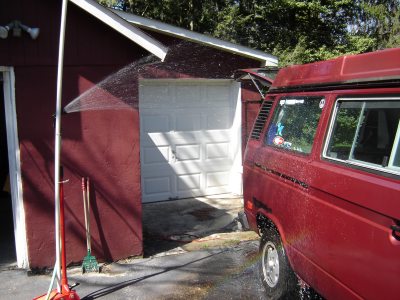
First, setup a water test rig, and get a good flashlight. I made a water rig out
of a garden hose, PVC pipe and a floor jack. Put the garden hose on "shower",
and lock it on with the metal ring on the backside of the hose sprayer. I used
some nylon ties to hold the hose and PVC to the jack.
Turn on the water in the general direction you wish to test, and then crawl
inside with a flashlight. Within 5 minutes I saw water on the rusty seam. I
turned off the hose and took a closer look at the body seam, and that's where I
saw it.
I had to remove the sliding door mechanical cover. Bentley
does a poor job of explaining how to get this part off (or at least its not
clear to me). Take out the two screws from the underside of the cover. Do not
pull the cover "out", Spray the plastic black seam with silicone spray - soak
the hell out of it. Take a rubber mallet and tap the cover from the bottom "up"
towards the top of the camper. Start from the back and move foreword. Do not
attempt to pull or move the plastic seam, it's a "key" for a "U" shaped channel
that the door cover sits in. Give it a few love taps and take it off.
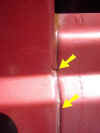
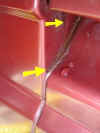
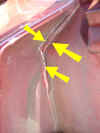 For the last picture, I have the sliding door mechanical cover
removed..
For the last picture, I have the sliding door mechanical cover
removed..
From here, I could see pretty clearly where the water was coming in. The
exterior body seams had cracked a little on the surface. My guess was that water
was getting in, and going for a ride in the seam down to where it would pool and
then start to rust. The cracks in the seam are unbelievably small. I'm talking
1-8 thousandths of an inch at the most.
So I took a metal pick and pulled out the entire old seam. Ouch. No fun, the
camper looks like crap now. But hey, if I leave this it will rust away to
nothing. Honestly at this point I am forgetting how it's going to look, and if
it's dry I'll be happy.
I then used a Dremel Moto-Tool with a small wire wheel on it and ran it up and down the seam a few times where I could fit it. This worked pretty well. Blew it dry with air and then wiped out the cracks with acetone.
(Side note, I later fixed this by removing the sealer with acitone, and then taping the seams with 3M blue painters tape, and then re-seaming the body. Run it in with your finger nice and thick, remove the tape and let it cure, in 24 hours paint it.. looks good..)
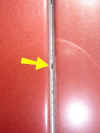
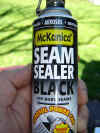
I then needed seam sealer. I made a stop to my local Auto-Body supply store and
asked them what the best stuff is for a paintable exterior seams. The guy
steered me to some stuff in a can called
McKanica Seam Sealer. It comes in three or so colors (white, black, yellow).
The stuff was nice to work with; it's in a pressured can, no gun needed,
paintable in 20 min, works on bare metal, or primed metal.
The issues are that it's sticky as all hell, and will stick to everything it
touches. Wear gloves and so far it takes a long time to cure. I'm on two days
and right now if I touch it (in a test spot) its still gummy. It's hard to
smooth, and I ended up smearing some around with my finger. I am not a pro.. and
it shows…
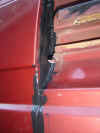
Later I water tested it again in the same spot, and YEY its dry! My 1st step to
stopping evil seam rust!
For now, I feel pretty good. I soaked the seam rust
(inside) with Rustoleum "Rust Converter"
which turned all the seam rust into a black mass that I let dry for 3 days, and
then painted over with "Hammer Tone"
Rustoleum paint. The stuff says it can go over rust, and I feel pretty
good about it. There are a few pin holes that go down into the wheel arch,
and well, I think I may scrape, and clean inside and cover with PRO-15 for now
and then coat it with roofing tar. My idea is that if I can keep the water
off of it, its going to never rust. But I know that's a lie I am telling
myself. If I can slow the rust waaaaay down I'll be happy. I don't
drive Schultz in the winter, and often never in bad weather.
Onto the other horror story of my seam rust, or rather the evil Worstfailure Curse OF THE LEAKING DRIVERS SIDE HOOKUP PORTS!!
